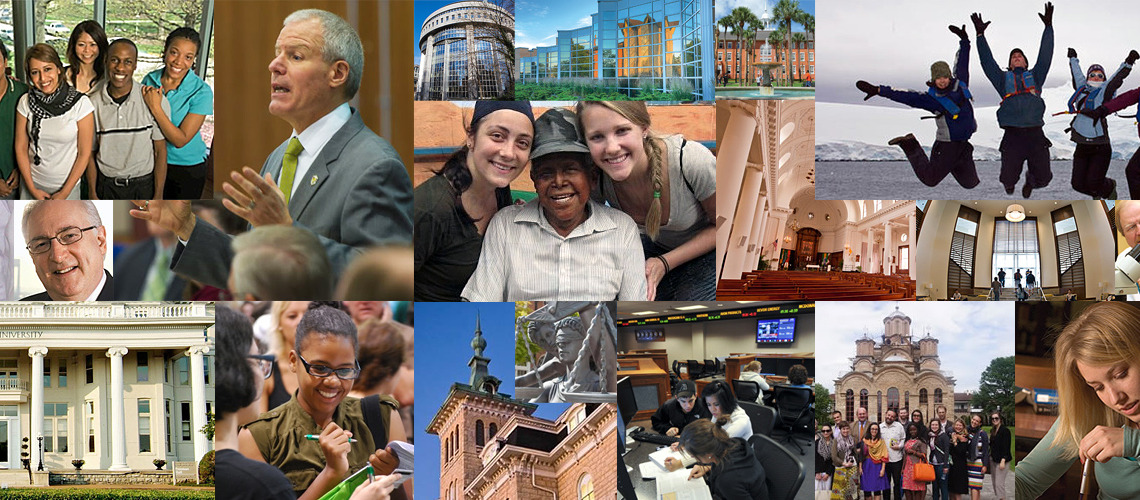
Founded in 1995, The New American Colleges and Universities is a national consortium of selective, small to mid-size (2,000 – 7,500 students) independent colleges and universities dedicated to the purposeful integration of liberal education, professional studies, and civic engagement. The New American Colleges and Universities collectively and individually are often cited as models of the intentional integration of teaching and learning, scholarship, and service.
Since its inception, this group of like-minded institutions has come together to forge partnerships and collaborations that enrich faculty work and improve student outcomes. To improve the quality and effectiveness of teaching and learning, The New American Colleges and Universities consortium sponsors projects and conferences, administrator and constituency groups, surveys and data benchmarking, and programs to expand student learning.
Its constituency groups gather regularly to share best practices and consult with one another to enhance institutional effectiveness, allowing its members to address challenges head-on with the knowledge and support of peers. Administrators and faculty who engage in NAC&U activities find a multi-dimensional community of practice in which various constituency groups share candid conversations and develop a sense of trust that allows them to openly discuss challenges and successes in a beneficial way.
Read more about the history of NAC&U.
NAC&U’s notable dates and accomplishments:
1990
In his landmark essay, “The Ugly Duckling of Higher Education,” University of Redlands Provost Frank Wong explored the identity and distinctive characteristics of comprehensive colleges and universities. His provocative thinking caused a group of chief academic officers from private colleges and universities to create a study group to explore the distinctive characteristics of their institutions.
1994
Ernest L. Boyer, president of the Carnegie Foundation for the Advancement of Teaching, called for a “New American College” that would renew the tradition of higher education service to society that he associated with the colonial liberal arts college and the land grand university system founded during the Civil War. Boyer spoke before a large crowd at the 1994 annual meeting of the Association of American Colleges and Universities. Later that year, a conference on the New American College held at Wingspread gave birth to the Associated New American Colleges.
1995
The Associated New American Colleges are founded as a national consortium of selective, small to mid-size (2,000-7,500 students) independent colleges and universities dedicated to the purposeful integration of liberal education, professional studies, and civic engagement.
1997
ANAC collaborates with The Carnegie Foundation for the Advancement of Teaching on a national faculty survey. The ANAC Faculty Work Project, supported by the Pew Charitable Trusts, developed a blueprint for enhancing faculty-institutional relationships in order to better accomplish the institutional mission.
2002
Anker Press publishes “A New Academic Compact: Revisioning the Relationship between Faculty and Their Institutions” based on the ANAC Faculty Work Project.
2003
ANAC establishes ANAC Study Abroad (ANACSA) to provide members’ students with more options for study abroad.
A TIAA-CREF Institute grant supports a faculty work project to analyze the generational turnover of faculty with a late-career faculty survey.
2006
ANAC is awarded a grant from the TIAA-CREF Institute for an early career faculty survey in collaboration with the University of Minnesota. The survey is part of ANAC’s project to address issues and challenges related to the turnover of approximately half of the current faculty cohort over the next decade, as the faculty generation born since 1940 and hired in the 1960s and 1970s retires.
2008
ANAC Student Exchange begins.
2009
The ANAC Board of Directors vote to change the name to The New American Colleges and Universities, reflecting the fact that most members are universities.
2011
NAC&U presents the first Ernest L. Boyer Award to Alexander and Helen Astin.
The Teagle Foundation awards NAC&U a planning grant for “Preparing and Evaluating 21st Century Faculty: Aligning Expectations, Competencies and Rewards.”
NAC&U welcomes its first president, Nancy Hensel.
2012
The Teagle Foundation awards NAC&U a grant for “Preparing 21st Century Students through New Visions for Faculty Evaluation, Campus Governance and Curriculum.”
2013
NAC&U’s Online Course Inventory launches.
NAC&U becomes a partner in AAC&U’s LEAP.
2015
NAC&U publishes “Redefining the Paradigm: Faculty Models to Support Student Learning.”
NAC&U launches Signature Experiences in its domestic study away program.
2016
At a Congressional Briefing, National Press Club Briefing, and AAC&U Annual Meeting, students from NAC&U campuses share how the integrated approach to liberal arts, professional studies and civic engagement has made an impact on their lives.
NAC&U Holds its First Science Summit at Belmont University.
Stylus Publishing Releases “The Power of Integrated Learning,” a book about NAC&U members’ approach to higher education, by William Sullivan
NAC&U Hosts Digital Scholarship Workshop at St. Edward’s University
2017
NAC&U Gives Inaugural Award for Student Excellence
*
Copyright note:
The text of this page is available for modification and reuse under the terms of the Creative Commons Attribution-Sharealike 3.0 Unported License and the GNU Free Documentation License (unversioned, with no invariant sections, front-cover texts, or back-cover texts).
